Germany Biodiversity and the Built Environment
Did you know that Germany has implemented the National Strategy on Biological Diversity to conserve and sustainably use biological diversity in the country?
The strategy focuses on environmental, economic, and social aspects, and involves government and non-governmental stakeholders. The Federal States also play a crucial role in preserving biodiversity. Germany has taken actions to achieve the 2020 Aichi Biodiversity Targets, including the protection of national natural heritage and the involvement of businesses in biodiversity conservation. The country has also established protected areas and implemented coastal zone management and climate change adaptation strategies. Legislation, funding, capacity-building, and coordination mechanisms support the national implementation of biodiversity conservation measures in Germany.
Key Takeaways:
- Germany has implemented the National Strategy on Biological Diversity to conserve and sustainably use biological diversity
- The strategy involves government and non-governmental stakeholders
- The Federal States play a crucial role in preserving biodiversity
- Germany has taken actions to achieve the 2020 Aichi Biodiversity Targets
- The country has established protected areas and implemented coastal zone management and climate change adaptation strategies
The Importance of Biodiversity Conservation
Biodiversity conservation plays a critical role in maintaining the health and functioning of ecosystems, contributing to the overall well-being of our planet. The preservation of biodiversity brings numerous benefits and supports various essential services that ecosystems provide. Let’s explore the importance of biodiversity conservation and its role in sustaining our environment and society.
The Benefits of Biodiversity
Biodiversity encompasses the incredible variety of life on Earth, including plants, animals, and microorganisms. Its conservation is vital for the following reasons:
- Healthy Ecosystems: Biodiversity is crucial for the stability and resilience of ecosystems. It enhances their ability to withstand disturbances, such as climate change and natural disasters, ensuring their long-term survival.
- Ecosystem Services: Biodiversity provides a wide range of valuable ecosystem services that directly benefit human well-being. These services include clean air and water, carbon sequestration, nutrient cycling, soil fertility, pest control, and pollination of plants.
- Environmental Sustainability: Biodiversity conservation is essential for sustainable development. It helps promote the responsible use of natural resources, maintain ecological balance, and preserve the integrity of ecosystems for future generations.
The Role of Biodiversity in Ecosystems
Biodiversity plays a fundamental role in maintaining the intricate balance of ecosystems by influencing various ecological processes. It contributes to:
- Species Interactions: Biodiversity supports important interactions among different species, such as predation, competition, and symbiosis. These interactions shape the structure and functioning of ecosystems, ensuring their stability.
- Food Webs: Biodiversity is the foundation of complex food webs, where species depend on each other for survival. The interdependence of species in these networks influences energy transfer and nutrient cycling, regulating ecosystem productivity.
- Resilience: Biodiversity enhances the resilience of ecosystems against disturbances and environmental changes. Diverse ecosystems are better equipped to adapt and recover from disruptions, making them more resistant to stressors.
By conserving biodiversity, we can safeguard the delicate balance of ecosystems, protect valuable ecosystem services, and maintain the health of our planet.
“In the end, we will conserve only what we love; we will love only what we understand, and we will understand only what we are taught.” – Baba Dioum
| Benefits of Biodiversity Conservation | Role of Biodiversity in Ecosystems |
|---|---|
| 1. Provides clean air and water | 1. Supports species interactions |
| 2. Enhances carbon sequestration | 2. Builds complex food webs |
| 3. Prevents erosion and soil degradation | 3. Improves ecosystem resilience |
| 4. Promotes pollination of plants | |
| 5. Offers recreational opportunities |
Sustainable Urban Planning in Germany
Germany is at the forefront of sustainable urban planning, with a strong focus on creating green cities that prioritize biodiversity conservation and incorporate green infrastructure. These innovative strategies are transforming urban landscapes and promoting a more environmentally conscious way of life.
One notable example of sustainable urban planning in Germany is the Solarsiedlung and Sonnenschiff in Freiburg. These developments showcase sustainable community living by incorporating renewable energy sources, such as solar power, and integrating green spaces throughout the neighborhoods. The aim is to create an environment that is not only visually appealing but also promotes a sense of harmony between urban living and nature.
The Vauban quarter, also located in Freiburg, is another remarkable development that embodies sustainable urban planning principles. This pedestrian-friendly area is designed to prioritize walking and cycling, reducing the reliance on cars. Energy-efficient buildings and green spaces are seamlessly integrated into the urban fabric, creating a vibrant and sustainable community.
“Sustainable urban planning in Germany goes beyond just constructing buildings. It is about creating livable environments that allow for a harmonious coexistence between people and nature.”
By embracing sustainable urban planning, Germany is striving to create livable cities that contribute to the conservation of urban biodiversity. The incorporation of green infrastructure, such as parks, green roofs, and urban forests, not only enhances the aesthetic appeal of these cities but also plays a significant role in maintaining and enhancing biodiversity.
The Benefits of Green Infrastructure:
- Enhanced air and water quality
- Improved urban microclimate regulation
- Increased habitat for native flora and fauna
- Reduced urban heat island effect
- Promotion of urban agriculture and local food production
The integration of sustainable urban planning principles and green infrastructure in Germany serves as an inspiration for other countries striving to create more environmentally sustainable cities. By prioritizing biodiversity conservation and incorporating green spaces into urban areas, Germany is leading the way in creating a healthier, happier, and more sustainable future.
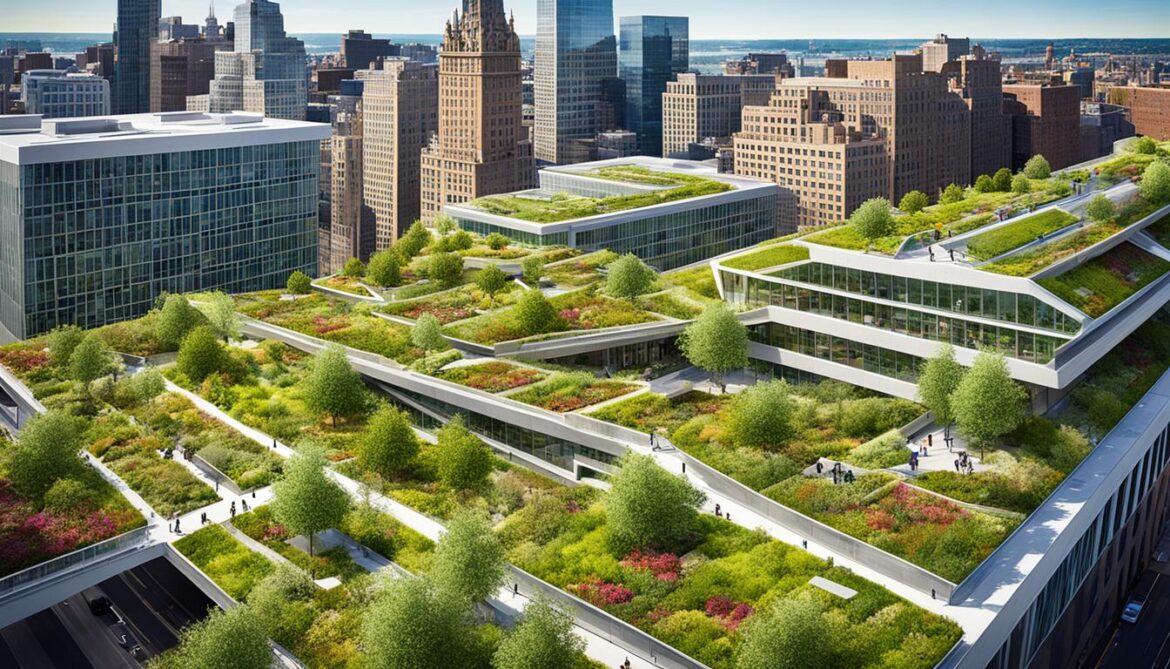
City Comparison – Green Infrastructure Initiatives
| City | Green Infrastructure Initiatives |
|---|---|
| Berlin | Integration of green roofs in buildings, urban farming initiatives |
| Hamburg | Expansion of urban forests, development of green corridors |
| Munich | Creation of extensive green spaces, promotion of active transportation |
Green Architecture in Germany
Germany is leading the way in sustainable architecture and eco-friendly buildings. The country is committed to creating a greener future through innovative designs and energy-efficient construction techniques. From cutting-edge developments to iconic landmarks, Germany showcases its dedication to green architecture.
Germany’s Most Sustainable Building: EDGE Suedkreuz
At the forefront of sustainable architecture in Germany is the EDGE Suedkreuz in Berlin. This remarkable building sets the standard for eco-conscious construction. Its modular hybrid-timber construction not only minimizes the carbon footprint but also creates a visually stunning structure. The EDGE Suedkreuz incorporates the latest sustainable technologies and eco-friendly features, making it the pinnacle of green architecture in Germany.
“The EDGE Suedkreuz is a testament to Germany’s commitment to sustainability. Its innovative design and energy-efficient features serve as an inspiration for future developments in the country and beyond.” – Sustainability expert
Iconic Green Buildings: Reichstag and Baufritz Houses
In addition to the EDGE Suedkreuz, Germany is home to other notable green buildings. The Reichstag building in Berlin is a prime example of sustainable architecture. It generates its own energy through renewable sources and sets an example for energy independence.
Baufritz-designed houses are renowned for their incorporation of green building techniques. These houses embrace passive solar design, harnessing natural light and heat to reduce energy consumption. With the use of non-toxic finishes, Baufritz houses provide a healthy and sustainable living environment.
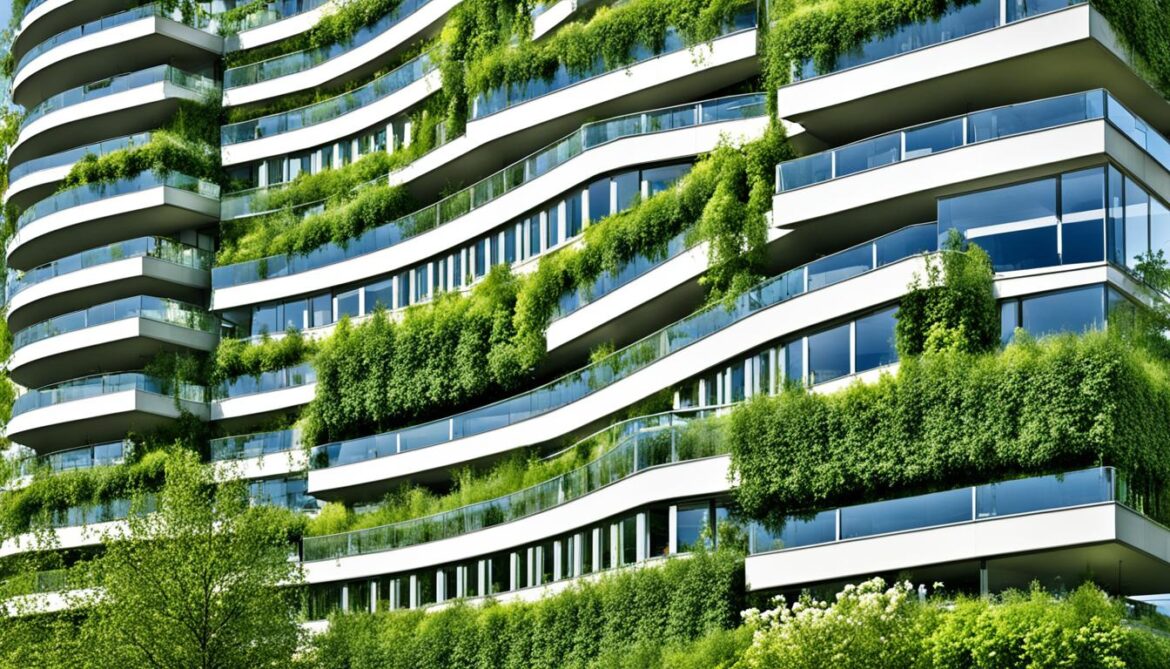
| Building | Location | Key Features |
|---|---|---|
| EDGE Suedkreuz | Berlin | Modular hybrid-timber construction, eco-friendly features |
| Reichstag | Berlin | Self-energy production |
| Baufritz Houses | Various locations | Passive solar design, non-toxic finishes |
The Role of Green Building Design
Green building design is instrumental in advancing Germany’s sustainable architecture movement. With a strong emphasis on environmentally friendly practices and sustainable materials, the country integrates energy-efficient systems, passive solar design principles, and non-toxic finishes into its structures. This commitment to green building design not only reduces the environmental impact of buildings but also creates healthier and more energy-efficient living and working spaces.
One noteworthy example of sustainable design is the EDGE Suedkreuz building in Berlin. Its modular hybrid-timber construction and eco-friendly features make it a prime example of green architecture in Germany. The building incorporates energy-efficient systems and technologies, exemplifying the country’s dedication to reducing energy consumption and carbon emissions.
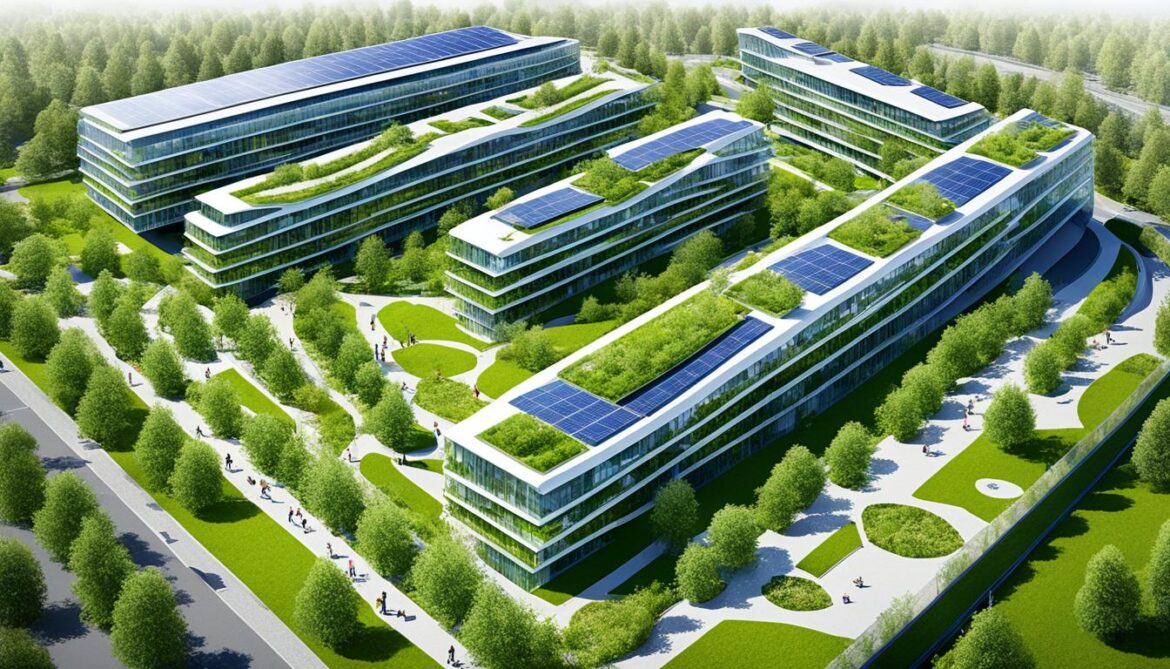
The Benefits of Green Building Design
Green building design offers numerous benefits to both the environment and building occupants. The integration of energy-efficient systems helps to conserve resources and reduce greenhouse gas emissions. By utilizing passive solar design principles, buildings can maximize natural lighting and heat absorption, reducing the need for artificial lighting and heating systems. Non-toxic finishes, on the other hand, create healthier indoor environments by minimizing the release of volatile organic compounds (VOCs) and other hazardous substances.
“Green building design not only reduces carbon emissions and conserves resources but also enhances the well-being and comfort of building occupants.”
Moreover, green building design improves the overall quality of life in urban areas. It enhances air and water quality, fosters greater connections to nature, and promotes a sense of well-being. The incorporation of green roofs, vertical gardens, and other forms of green infrastructure helps to mitigate the urban heat island effect, reduce stormwater runoff, and support urban biodiversity. These features not only create visually appealing environments but also contribute to a more sustainable and resilient built environment.
The Future of Green Building Design
The adoption of green building design and sustainable practices is expected to continue increasing in Germany and around the world. As the urgency to combat climate change grows, governments, architects, and developers are recognizing the importance of creating energy-efficient and environmentally responsible buildings.
Looking ahead, the future of green building design holds immense potential for innovation. Advances in technology and materials will enable the development of even more sustainable and energy-efficient building solutions. The integration of renewable energy technologies, such as solar panels and geothermal systems, will further reduce reliance on fossil fuels and minimize the environmental impact of buildings.
| Key Benefits of Green Building Design | Examples |
|---|---|
| Energy efficiency | The EDGE Suedkreuz building in Berlin utilizes advanced energy-efficient systems and technologies. |
| Improved indoor air quality | Non-toxic finishes in Baufritz-designed houses create healthier indoor environments. |
| Better thermal comfort | Passive solar design principles incorporated into buildings maximize natural lighting and heat absorption. |
| Reduced carbon emissions | Energy-efficient buildings contribute to a decrease in greenhouse gas emissions. |
| Promotion of urban biodiversity | Green roofs and vertical gardens support urban biodiversity and mitigate the urban heat island effect. |
Noteworthy Green Developments in Germany
Germany has implemented noteworthy green developments that showcase sustainable living and urban planning. Two prominent examples are the Solarsiedlung and Sonnenschiff in Freiburg, as well as the Vauban quarter.
Solarsiedlung and Sonnenschiff
The Solarsiedlung and Sonnenschiff in Freiburg are sustainable projects that demonstrate the integration of renewable energy sources, energy-efficient buildings, and green spaces in creating sustainable communities. The Solarsiedlung, which translates to “Solar Settlement,” is a residential neighborhood that utilizes solar energy for heating and electricity. It features energy-efficient buildings, photovoltaic panels, and innovative water management systems. The Sonnenschiff, or “Sun Ship,” is an eco-friendly building that relies on solar power and houses various functions, including residential, commercial, and educational spaces. The project serves as a remarkable example of sustainable design and showcases Germany’s dedication to green development.
Vauban Quarter
The Vauban quarter, also located in Freiburg, is another noteworthy green development in Germany. This sustainable urban planning project prioritizes pedestrian-friendly areas and the integration of green infrastructure. The quarter features car-free zones, energy-efficient buildings, and a comprehensive public transportation network. It aims to create a livable and environmentally conscious community by promoting sustainable mobility options and green spaces. The Vauban quarter exemplifies Germany’s commitment to sustainable urban planning and serves as a model for future eco-friendly developments.
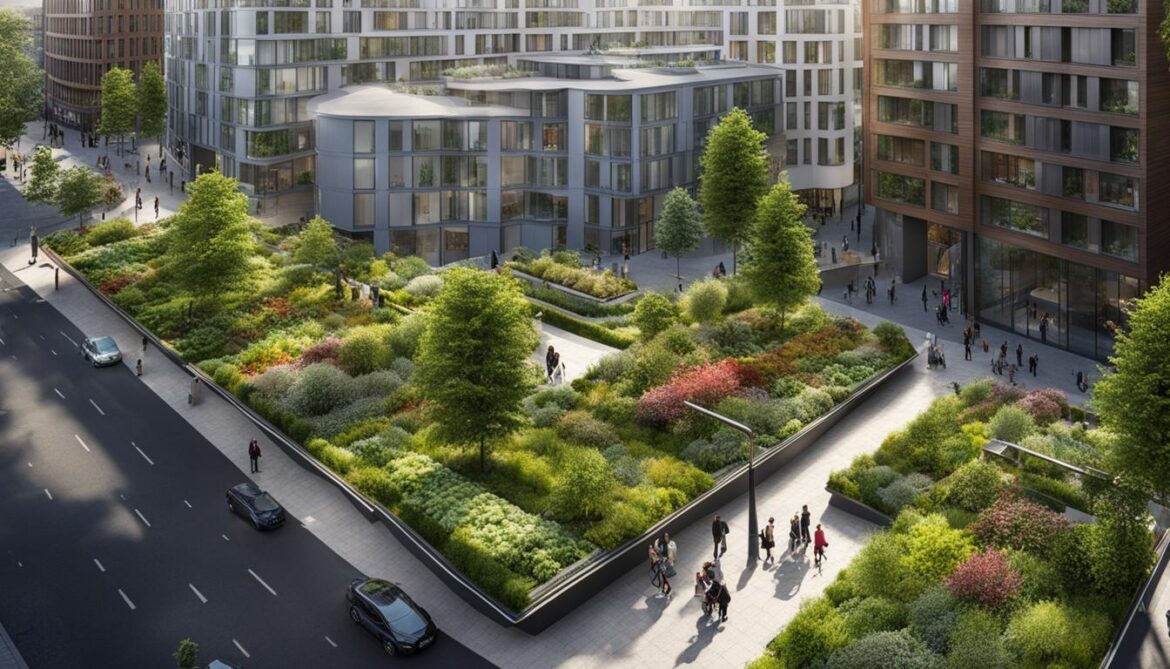
| Project | Location | Main Features |
|---|---|---|
| Solarsiedlung | Freiburg | – Integration of renewable energy sources – Energy-efficient buildings – Photovoltaic panels – Innovative water management systems |
| Sonnenschiff | Freiburg | – Solar-powered building – Residential, commercial, and educational spaces – Emphasis on sustainability |
| Vauban Quarter | Freiburg | – Pedestrian-friendly areas – Car-free zones – Energy-efficient buildings – Comprehensive public transportation network |
Energy Efficiency in Green Buildings
Energy efficiency is a critical aspect of green buildings. Germany places great emphasis on integrating energy-efficient systems, renewable energy sources, and sustainable building materials to reduce energy consumption and minimize environmental impact. By prioritizing eco-friendly building systems, Germany is at the forefront of sustainable development in the built environment.
One remarkable example of energy-efficient green building design in Germany is the EDGE Suedkreuz. This cutting-edge structure incorporates advanced technologies, such as carbon-capturing facades and energy-efficient systems. By implementing these innovative features, the EDGE Suedkreuz achieves exceptional levels of energy efficiency while ensuring a comfortable and sustainable living space.
Furthermore, renewable energy integration is a key component of energy efficiency in green buildings. Germany’s commitment to sustainability can be seen in its efforts to promote the use of renewable energy sources, such as solar and wind power, for powering green buildings. This integration reduces reliance on conventional energy sources, resulting in lower carbon emissions and a reduced environmental footprint.
In addition to renewable energy integration, the utilization of sustainable building materials further enhances energy efficiency in green buildings. Germany actively promotes the use of eco-friendly materials that minimize environmental impact throughout the entire construction process. From low-emissivity windows to energy-efficient insulation, these sustainable materials contribute to the overall energy efficiency of the building, reducing energy consumption and promoting a greener built environment.

Advantages of Energy Efficiency in Green Buildings
- Lower energy consumption and reduced carbon emissions
- Cost savings through reduced utility bills
- Improved indoor air quality and comfort
- Enhanced market value and higher occupancy rates
- Contribution to mitigating climate change and promoting sustainable development
The Future of Energy Efficiency
As the world continues to prioritize sustainability and environmental conservation, the future of energy efficiency in green buildings looks promising. Germany’s commitment to energy-efficient practices sets an inspiring example for other nations to follow. Advancements in technology, the growing availability of renewable energy sources, and increased public awareness about the importance of sustainable living will play significant roles in further enhancing energy efficiency in green buildings.
By continuously integrating energy-efficient systems, renewable energy integration, and sustainable building materials, the green building industry will contribute to a more sustainable and resilient future. Energy efficiency in green buildings is not only beneficial for the environment but also for the well-being of individuals and communities. It is a key component of sustainable development and a crucial step towards achieving a greener and more sustainable built environment.
| Advantages of Energy Efficiency in Green Buildings | Future of Energy Efficiency |
|---|---|
| Lower energy consumption and reduced carbon emissions | Continuous advancements in technology |
| Cost savings through reduced utility bills | Increased availability of renewable energy sources |
| Improved indoor air quality and comfort | Growing public awareness about sustainable living |
| Enhanced market value and higher occupancy rates | Contributing to a more sustainable and resilient future |
| Contribution to mitigating climate change and promoting sustainable development | Achieving a greener and sustainable built environment |
The Impact of Green Architecture on Climate Change
Green architecture plays a significant role in mitigating climate change and creating a more sustainable future. By integrating energy-efficient systems, renewable energy sources, and sustainable building materials, green buildings in Germany contribute to reducing carbon emissions and the overall carbon footprint.
With an emphasis on sustainable design and construction practices, green architecture helps create a resilient built environment that can withstand the challenges posed by climate change. By incorporating innovative technologies and eco-friendly materials, these buildings set a standard for low-carbon living and contribute to a greener future for all.
“Green architecture is not only about reducing energy consumption, but also about minimizing environmental impact and promoting a more sustainable way of life.” – Sustainable Architect
One of the key goals of green architecture is to reduce the carbon footprint associated with the construction and operation of buildings. By utilizing energy-efficient systems, green buildings in Germany can significantly decrease energy consumption, leading to lower greenhouse gas emissions. This reduction in carbon emissions helps combat climate change and contributes to the global efforts to curb its adverse effects.
Moreover, green architecture also promotes the use of renewable energy sources, such as solar and wind power. Incorporating these sustainable energy solutions into buildings not only reduces dependency on non-renewable resources but also decreases reliance on fossil fuels, further reducing carbon emissions and mitigating climate change.
The Importance of Sustainable Building Solutions
Sustainable building solutions go beyond energy efficiency and renewable energy integration. They encompass a holistic approach to construction that considers the entire lifecycle of a building, from design and construction to operation and eventual disposal or reuse.
Green buildings prioritize resource efficiency, waste reduction, and the use of sustainable materials. Through practices such as rainwater harvesting, graywater recycling, and waste management systems, these buildings minimize the strain on natural resources and contribute to environmental conservation.
The integration of green spaces and green infrastructure also plays a vital role in sustainable building solutions. By incorporating vegetation and natural elements into the built environment, green buildings enhance biodiversity and provide numerous ecological benefits, such as improved air quality, temperature regulation, and urban habitat creation.
By adopting sustainable building solutions, Germany not only addresses climate change but also promotes a more resilient and environmentally conscious society.
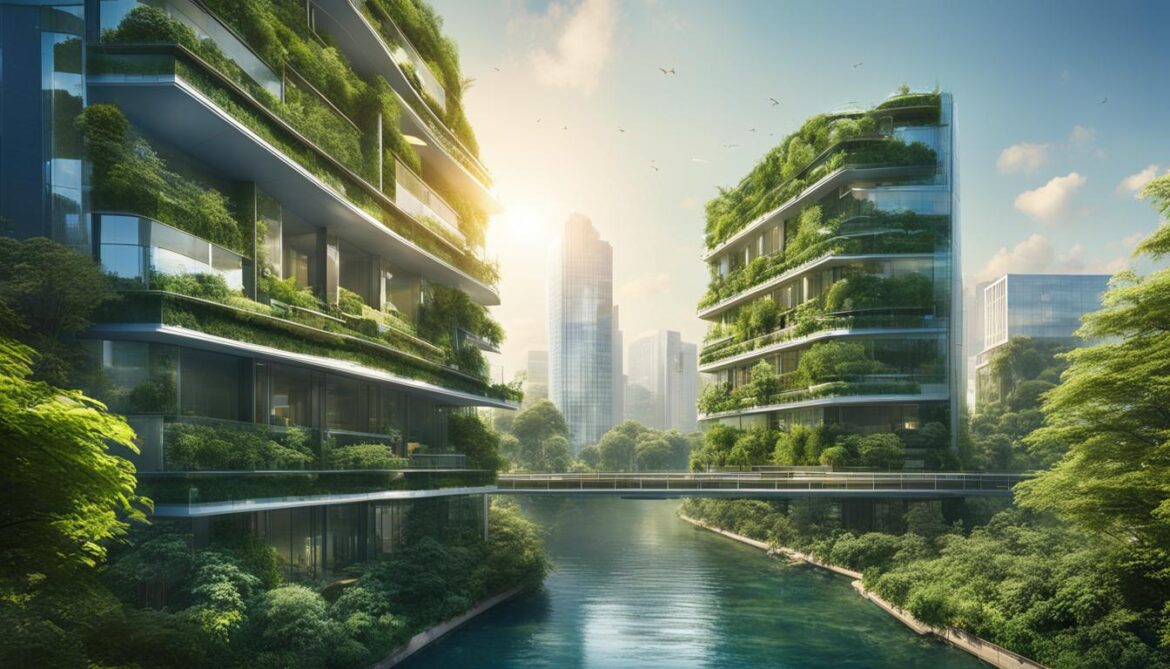
The Path to a Low-Carbon Future
The impact of green architecture on climate change extends beyond the individual buildings. It sets a precedent for sustainable urban development and inspires the transition to a low-carbon future at a larger scale.
Green architecture showcases the potential for sustainable design and construction practices to be implemented in various building types, from residential and commercial to institutional and public spaces. By influencing urban planning and development, green architecture contributes to the creation of eco-friendly cities that prioritize carbon footprint reduction, biodiversity conservation, and human well-being.
Germany’s commitment to green architecture and sustainable building solutions serves as a model for other countries striving to address climate change and create a more sustainable world. By embracing these practices, we can collectively work towards a future where buildings are not just structures but integral components of a sustainable and resilient planet.
The Benefits of Biodiversity in the Built Environment
Biodiversity in the built environment provides numerous benefits to human well-being. Green spaces and green infrastructure promote mental and physical health, improve air and water quality, and create aesthetically pleasing environments.
“The beauty and tranquillity of nature in urban areas have a significant positive impact on our mental well-being.”
Biodiversity plays a crucial role in enhancing the resilience of urban areas by providing ecosystem services. For instance, green spaces help mitigate the risk of flooding by absorbing excess water and reducing runoff. They also contribute to regulating temperatures and reducing noise levels in cities.
One study conducted in Germany found that the presence of green spaces in urban areas can significantly reduce the risk of heat-related illnesses during heatwaves, improving the overall well-being of residents.
Integrating biodiversity into the built environment is essential for creating sustainable and livable cities. By preserving and enhancing natural areas within urban landscapes, we can reap the benefits of ecosystem services, improve our quality of life, and ensure the well-being of future generations.
| Benefits of Biodiversity in the Built Environment: | Ecosystem Services: |
|---|---|
| 1. Improved mental and physical health | 1. Flood mitigation |
| 2. Enhanced air and water quality | 2. Temperature regulation |
| 3. Aesthetically pleasing environments | 3. Noise reduction |
By recognizing the value of biodiversity in the built environment, we can prioritize the integration of green spaces and green infrastructure in our cities. This proactive approach not only benefits our own well-being but also supports the long-term sustainability and resilience of urban areas in the face of environmental challenges.
Challenges and Future Directions
Despite Germany’s progress in biodiversity conservation and sustainable development, challenges remain. Urbanization, habitat loss, and climate change pose threats to biodiversity and the built environment.
To overcome these challenges, Germany needs to continue implementing and promoting sustainable practices, raising awareness about the importance of biodiversity, and integrating nature into urban planning. The future of sustainable development in Germany relies on ongoing efforts to balance economic growth with environmental preservation.
The Challenges in Biodiversity Conservation
The preservation of biodiversity faces various challenges in Germany. Urbanization, driven by population growth and the expansion of cities, leads to the loss and fragmentation of habitats. This habitat loss disrupts ecosystems, displaces wildlife, and reduces biodiversity. Additionally, the intensification of agricultural practices and the use of pesticides contribute to the decline of pollinators and the loss of vital habitat for many species.
Climate change is another significant challenge that affects biodiversity conservation in Germany. Rising temperatures, changing precipitation patterns, and extreme weather events disrupt ecosystems and impact the distribution and abundance of species. Climate change poses an additional threat to already vulnerable habitats and species, increasing the urgency of conservation efforts.
The Future of Sustainable Development in Germany
To tackle these challenges and secure a sustainable future, Germany must prioritize the implementation of sustainable practices. This includes promoting renewable energy sources, encouraging energy efficiency in buildings and transportation, and supporting sustainable agriculture. By transitioning to a low-carbon economy and reducing resource consumption, Germany can mitigate the impacts of climate change and preserve biodiversity.
Furthermore, raising awareness among the general public about the importance of biodiversity and ecosystem services is crucial. Education and outreach programs can engage communities and foster a sense of responsibility towards nature. By involving citizens in biodiversity conservation efforts, Germany can create a collective commitment to sustainable development.
Integrating nature into urban planning is another essential step towards a more sustainable future. Green spaces, such as parks, gardens, and green roofs, provide habitats for wildlife, improve air quality, and enhance overall well-being. By incorporating green infrastructure and prioritizing biodiversity in urban design, Germany can create resilient cities that harmoniously coexist with nature.
Table: Challenges in Biodiversity Conservation and Future Directions
| Challenges | Future Directions |
|---|---|
| 1. Urbanization | 1. Integrating nature into urban planning |
| 2. Habitat loss | 2. Promoting sustainable practices in agriculture and land use |
| 3. Climate change | 3. Transitioning to a low-carbon economy |
| 4. Intensification of agriculture | 4. Encouraging sustainable farming practices |
| 5. Lack of awareness | 5. Educating the public about the importance of biodiversity |
Despite the challenges ahead, Germany’s commitment to sustainable development and biodiversity conservation provides hope for a greener future. With continued efforts and collaboration among various stakeholders, Germany can lead the way in setting an example for other nations in creating a harmonious balance between development and environmental preservation.
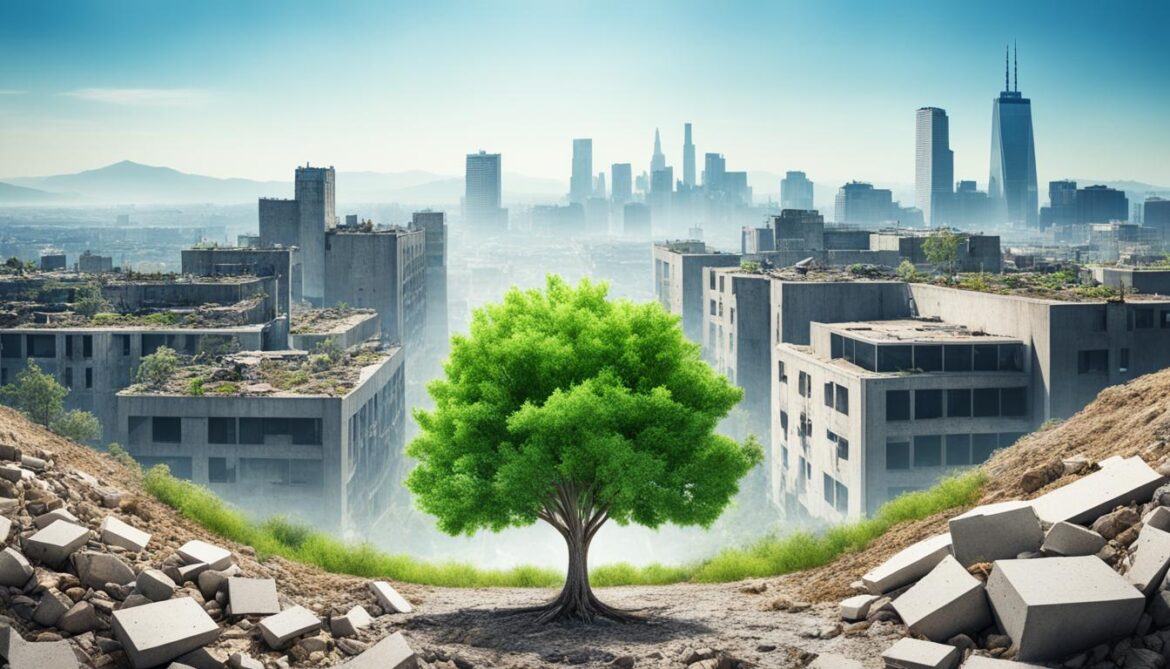
The Role of Stakeholders in Biodiversity Conservation
Biodiversity conservation requires collaboration among various stakeholders, including government agencies, non-governmental organizations, businesses, and local communities. In Germany, the National Strategy on Biological Diversity involves governmental and non-governmental players at all levels, fostering dialogue and creating alliances.
The engagement of the younger generation and the participation of the Federal States and municipalities also play crucial roles in preserving biodiversity. Active involvement and cooperation among stakeholders are vital for the successful conservation of biodiversity in the built environment.
| Stakeholders | Roles |
|---|---|
| Government agencies | Developing and implementing policies and regulations |
| Non-governmental organizations | Advocacy, research, and on-the-ground conservation efforts |
| Businesses | Integrating sustainable practices into their operations |
| Local communities | Engaging in community-based conservation projects |
Through collaboration and shared responsibility, stakeholders can effectively address the various challenges to biodiversity conservation and work towards building a sustainable future for the built environment.
Conclusion
Germany has showcased a remarkable dedication to preserving biodiversity and promoting sustainable development in the built environment. The country’s implementation of the National Strategy on Biological Diversity, coupled with its emphasis on green building design practices and the creation of noteworthy green developments, has positioned Germany as a global leader in shaping a greener and more sustainable future.
Despite the challenges that persist, such as urbanization, habitat loss, and climate change, Germany remains steadfast in its commitment to integrating biodiversity into urban planning and raising awareness about its importance. These ongoing efforts provide a glimmer of hope for continued progress in protecting and conserving biodiversity. Germany serves as an inspiring example for other nations seeking to strike a balance between economic growth and environmental preservation.
In conclusion, Germany’s unwavering dedication to biodiversity conservation and sustainable development sets it apart as a nation at the forefront of environmental stewardship. The implementation of the National Strategy on Biological Diversity, the adoption of green building design practices, and the creation of innovative green developments demonstrate Germany’s commitment to creating a more sustainable and livable built environment. Through ongoing efforts, Germany showcases the inseparable relationship between biodiversity and the built environment, inspiring other countries to follow suit in their pursuit of a greener future.








